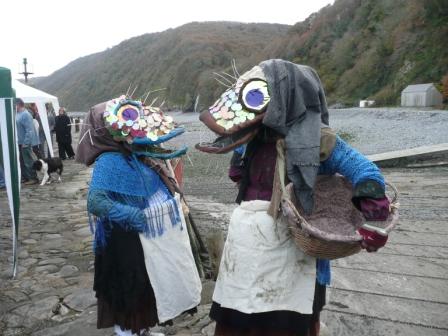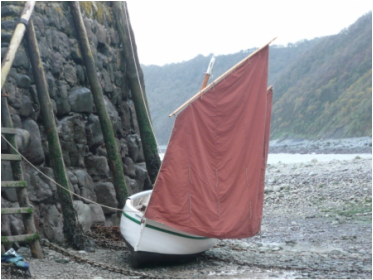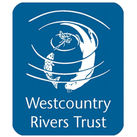| Park above Clovelly, search for the harbour, and at first all you will see is thick woods wearing their Autumn colours, a sea as blue as the sky will allow, slate grey cliffs and a stony shore. The ancient village, tucked in the shelter of the cliffs, hides its secrets well. Cars are banned from Clovelly, so take the opportunity to meander slowly down the history-rounded cobbles and let each bend reveal its story. On a normal winter’s day the steep streets are quiet, just the odd fat cat disappearing behind narrow alleyways. It’s easy to take yourself back in time and imagine donkeys heavily laden with wicker baskets, brim-full of fish, plodding slowly upwards. The sledges which villagers still use to cart their goods up or down are stacked outside the cottages. But on Sunday 16th November the first warning that the village is not sleeping will be the mellow sound of sea shanties drifting up the natural amphitheatre of cliffs. The shops which spill out from the white-painted cottages on “Down-along street” will be open, so will the Charles Kingsley (author of Westward Ho!) museum, so allow plenty of time. |
| Then turn a corner and from the spot where wives used to watch for returning fishing boats, two arms appear to hug the tiny harbour in a protective, benevolent embrace. The right arm is the sea cliffs leading round to Westward Ho and beyond; the left the man-made harbour wall, decked with stalls, full of local produce and crafts. One final leg and the herring festival with all its bustle and colour is laid out before you. Coming in from the top (you can always ride back up in the landrover!) allows you to plan your day. Take it slowly, breakfast lightly, remember one of the things on offer is lots of different ways to sample the delights of Clovelly herring. |
| Stephen explained that picarooners were favoured because they could get into the water and out to a dancing shoal quicker, beating the heavier boats. In those days most of the village men and many women were employed in the herring industry. Stephen was only 12 in 1977 when the nation-wide herring ban grounded the handful of active herring boats, including his father’s. Although the ban only lasted 7 years, during that time, his father and two other traditional herring men died and the industry never recovered. | Before you join the throng, check the boats and look for the traditional Clovelly herring boat –the Picarooner. Built by students at Falmouth marine college -with its simple graceful lines and two red sails - it is beautiful. Stephen Perham harbour master and herring fisherman had her built because he is determine to catch herrings in the traditional way - using oars or sail. And for out seventh film Boat Stories has just been out in the picarooner herring fishing - with Stephen and Peter Braund doing all the hard work. |
The brothers may well be the last of Clovelly’s herring men. I asked them whether the herring themselves had recovered. “Yes, there’s big numbers now in the bay. But they’re still a notoriously fickle fish,” Stephen replied. “Sometimes I fill the boat in ten minutes. Other days we shoot away and catch nothing.” “They hide in the bottom,” adds Tommy, "then rise to the changing light, so the best time to catch them is dawn or dusk. They play for high water and the ebb and flow of the tide.” The brothers are keen to point out that they fish sustainably, using gill nets, drifting on the tide, with holes large enough for the smaller fish to slip through.
| “It’s not the fish that have dried up,” declares Tommy, “but the market. They’re seasonal, like strawberries or mackerel. Customers used to knock on the door asking whether they’d arrived. Now you can get fish 24/7 from supermarkets, ready gutted and prepared. A whole generation of local children has grown up without knowing the special taste of Clovelly herring.” And that’s why the brothers are passionate about the herring festival – now an annual event. “Why are herring so special?” I ask. The herring swim down from the Irish Sea, arriving in the sheltered waters of Bideford Bay from September on, ready to spawn and lay their eggs. Ripe for breeding, Clovelly herring are in peak condition, rich with health-giving fish oils, succulent and sweet. Go to the festival and try them. Stephen and his sister Rachel will be pan fry fresh herring –simple and delicious. Joe Rossi (Stephen’s nephew) will show you how to cook herring roe –male and female. Roberta will offer marinated herring with a selection of sauces on wild yeast blinis. Jim and Beth from Seadog will be cooking their trademark exotic, world-inspired, street food. And of course there are kippers! Mike Smylie’s smokehouse reminds me of the compost loos found at festivals. I’m allowed a quick peep at the racks of herring smoking inside. I wasn’t sure I liked kippers, until I tasted these, moist, yet sweet and mild, not over-powerful in taste or colour unlike the bright orange supermarket kippers. |








 RSS Feed
RSS Feed











